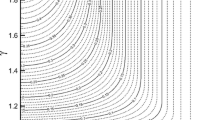Abstract
This paper covers an extension of the study of Doctors et al. (J Ship Res 52(4):263–273, 2008) on oscillations in wave resistance during the constant-velocity phase of a towing-tank resistance test on a ship model to the case of relatively shallow water. We demonstrate here that the unsteady effects are very prominent and that it is essentially impossible to achieve a steady-state resistance curve in a towing tank of typical proportions for a water-depth-to-model-length ratio of 0.25. This statement is particularly true in the speed region near a depth Froude number of unity. However, on the positive side, we show here that an application of unsteady linearized wave-resistance theory provides an excellent prediction of the measured total resistance, when one accounts for the form factor in the usual manner. Finally, a simple application of the results to the planning and analysis of towing-tank tests is presented.







Similar content being viewed by others
References
Lewis EV (ed) (1988) Principles of naval architecture: volume II. Resistance, propulsion and vibration. Society of Naval Architects and Marine Engineers, Jersey City, New Jersey, 327+vi pp
Doctors LJ, Day AH, Clelland D (2008) Unsteady effects during resistance tests on a ship model in a towing tank. J Ship Res 52(4):263–273
Lunde JK (1951) On the linearized theory of wave resistance for displacement ships in steady and accelerated motion. Trans Soc Naval Archit Mar Eng 59:25–76. Discussion: 76–85
Lunde JK (1953) A note on the linearized theory of wave resistance for accelerated motion. Norges Tekniske Høgskole, Skipsmodelltanken, Report 27, 14 pp
Sretensky LN (1936) On the wave-making resistance of a ship moving along in a canal. Philos Mag Ser 7 Suppl 22(150):1005–1013
Michell JH (1898) The wave resistance of a ship. Philos Mag Lond Ser 5, 45:106–123
Doctors LJ, Sharma SD (1972) The wave resistance of an air-cushion vehicle in steady and accelerated motion. J Ship Res 16(4):248–260
Doctors LJ (1975) The experimental wave resistance of an accelerating two-dimensional pressure distribution. J Fluid Mech 72(Part 3):513–527
Wehausen JV (1964) Effect of the initial acceleration upon the wave resistance of ship models. J Ship Res 7(3):38–50
Djachenko VK (1970) The wave resistance of a surface pressure distribution in unsteady motion. University of Michigan, Department of Naval Architecture and Marine Engineering, Report 44, 12+ii pp
Shebalov AN (1970) Theory of ship wave resistance for unsteady motion in still water. University of Michigan, Department of Naval Architecture and Marine Engineering, Report 67, 14+i pp
Çalişal S (1977) Effect of initial acceleration on ship wave pattern and wake survey methods. J Ship Res 21(4):239–247
Sibul OJ, Webster WC, Wehausen JV (1979) A phenomenon observed in transient testing. Schiffstechnik 26(4):179–200
Wigley WCS (1934) A comparison of experiment and calculated wave-profiles and wave-resistances for a form having parabolic waterlines. Proc R Soc Lond Ser A 144(851):144–159 (+ 4 plates)
Becker E (1956) Die Pulsierende Quelle unter der Freien Oberfläche eines Stromes Endlicher Tiefe. Ingenieur-Archiv 24(2):69–76
Becker E (1958) Das Wellenbild einer unter der Oberfläche eines Stromes Schwerer Flüssigkeit Pulsierenden Quelle. Zeitschrift für Angewandte Mathematik und Mechanik 38(9/10):391–399
ITTC (2008) ITTC—recommended procedures and guidelines: testing and extrapolation methods for resistance test. Twenty-Fifth International Towing Tank Conference, Procedure 7.5-02-02-01, Fukuoka, Japan, 14 pp
Acknowledgments
We would like to thank the Engineering and Physical Sciences Research Council (EPSRC), for their support of this work under the project title, “Experimental and Theoretical Study of Ship Resistance with Unsteady Forward Speed”, Reference EP/F019998/1. We would also like to express our appreciation to Mr Charles Keay, Laboratory Coordinator, who supervised the construction of the ship model and the specialized dynamometer. He also oversaw the operation of the towing-tank. In addition, we are very grateful to Mr Jakub Cichowicz, who assisted with the data logging and who created the data files for subsequent computer processing. Finally, we also gratefully acknowledge the infrastructure support provided by The University of New South Wales (UNSW).
Author information
Authors and Affiliations
Corresponding author
Appendix: Formulation for unsteady wave resistance
Appendix: Formulation for unsteady wave resistance
The formulation is identical to that published by Doctors et al. [2]. We repeat it here for the convenience of the reader. The final result for the wave resistance is:
The first term in Eq. 16 relates to the inertia of the water and is simply proportional to its density ρ. This term equals the product of the acceleration and the thin-ship infinite-Froude-number added mass of the vessel. The integrals in Eq. 18 are effected over the centerplane area of the vessel S 0. The geometry of the vessel enters the equation through the appearance of its local beam b(x,z). The symbol ′ is used to distinguish the source variables from the field variables. The two radial distances from the source point to the field point are
It can be demonstrated that, as the Froude number approaches zero, the second term in Eq. 16 approaches twice the negative of the image-sink distribution. Thus, at such low speeds, one can model the hydrodynamics of the vessel using just a simpler, added-mass, concept.
The second term in Eq. 16 relates to wave effects. Here, s(t) is the distance traveled from the start of the motion. We also have
The wave numbers k x and k y are related to the circular wave number k and the wave angle θ through the relationship:
The summation factor \(\epsilon\) and the transverse wave number k y are given by the formulas:
The index i of the summation in these equations has been dropped for the sake of simplicity.
Finally, the finite-depth wave functions in Eq. 18 are given by the formulas
in which the Michell deep-water wave functions P ± and Q ± are
About this article
Cite this article
Day, A.H., Clelland, D. & Doctors, L.J. Unsteady finite-depth effects during resistance tests on a ship model in a towing tank. J Mar Sci Technol 14, 387–397 (2009). https://doi.org/10.1007/s00773-009-0057-2
Received:
Accepted:
Published:
Issue Date:
DOI: https://doi.org/10.1007/s00773-009-0057-2



